Summer Scourges (The Injury Bug): A Photo Essay
Images of Achilles tendon injuries, rotator cuff tears, FOOSH (fall on outstretched hand) injury, superficial abrasion, Lisfranc joint injury, and avulsion fracture.
Achilles tendon injuries are common in persons who participate in a variety of summer sports activities, including running, baseball, softball, tennis, volleyball, and badminton. The Achilles tendon ruptures about 2.5 to 3 inches above its insertion into the calcaneus (marked). This, the "watershed area" of the tendon, has a tenuous blood supply, which makes it susceptible to rupture.
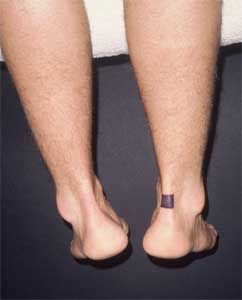
Image courtesy of John G. Aronen, MD and James G. Garrick, MD.
Click here for the next image
The rotator cuff may be injured when an athlete’s arm goes over his or her head, as in tennis, baseball, beach volleyball, and swimming. Weakness, especially in external rotation or abduction, is an important physical finding that indicates full-thickness rotator cuff tears. Testing of strength in external rotation is accomplished by having the patient place his arms at his sides with the elbows bent 90°. The examiner pushes against the patient’s wrists. Weakness in the patient’s resistance indicates some process affecting the infraspinatus muscle.
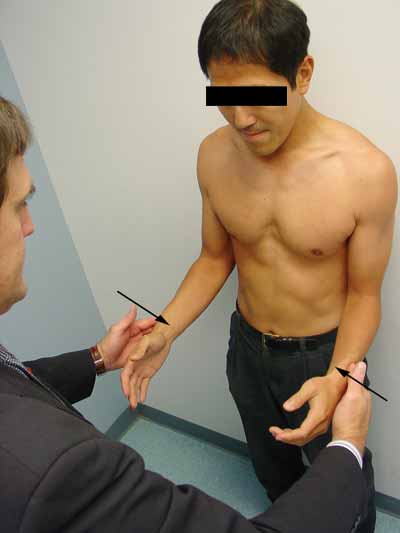
Image courtesy of Edward G. McFarland, MD, Prakasit Sanguanjit, MD, Atsushi Tasaki, MD, and Michael T. Freehill, MD.
Click here for the next image
A 27-year-old man presented a day after sustaining a FOOSH (fall on outstretched hand) injury while roller skating. He complained of pain when pronating and supinating his left arm. A lateral plain x-ray film shows an anterior and posterior fat pad sign on the left elbow. A second image revealed a slight hematoma positioned medially and just inferior to the radial head. Superficial bruising was also noted on the medial aspects of the distal humerus and proximal ulna bones. FOOSH injuries associated with acute onset of pain at the elbow raise suspicion of fracture of the radial head, proximal ulna, or humeral condyle as well as soft tissue injury.
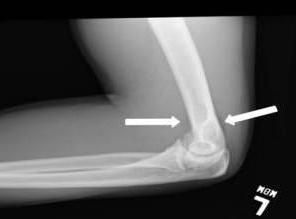
Image courtesy of Sean Sims, PA-S and Curtis Grenoble, PA-C.
Click here for the next image
A 30-year-old man was participating in a charity bicycle marathon when he accidentally fell off his bicycle, striking the path. This is clearly a superficial abrasion, although some fine particles of gravel are visible within the wound. Sutures are not indicated. The patient requested hydrogen peroxide rinse. Note, however, that hydrogen peroxide is now thought to be irritating to tissue and is not recommended for use in rinsing out a traumatic wound. Water (or saline) is preferable.
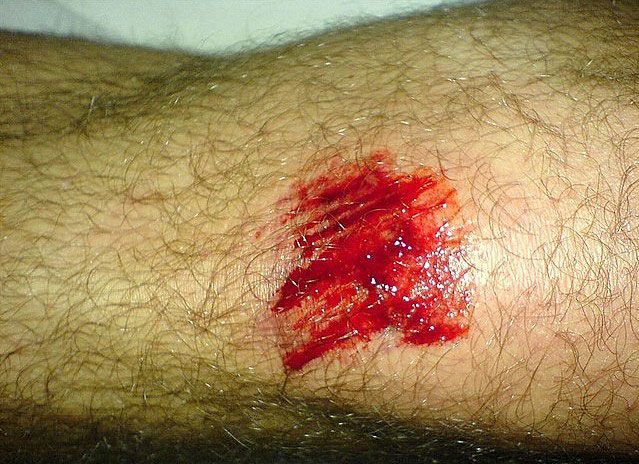
Image courtesy of Ted Rosen, MD.
Click here for the next image
A 17-year-old boy decided to try some new moves with his skateboard on a steep ramp. He tumbled head over heels and landed with most of his weight on his plantar-flexed right foot. When he tried to stand up, he felt pain on the top of the foot and could not bear weight. There was significant swelling and ecchymosis from the dorsum of the midfoot to the toes. There was marked tenderness over the second and first tarsometatarsal joints in the midfoot but none on the plantar surface, lateral or medial malleolus, or fifth metatarsal head. Radiographs revealed a 3- to 4-mm diastasis between the base of the first and second metatarsals, evidence of a Lisfranc joint injury. The most common type is a sprain that results from a simple fall or a sports-related injury.
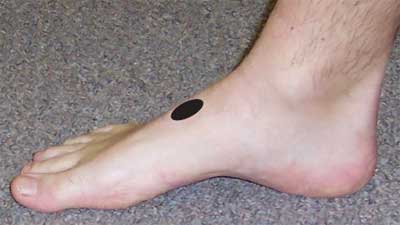
Image courtesy of Edward J. Shahady, MD, Willis Paull, PhD, and Brian Reece.
Click here for the next image
A 14-year-old girl came to the office with severe hip pain after she attempted a cheerleading maneuver on a trampoline. She was bouncing as high as she could and landed with her left knee flexed and her right hip extended. On impact, she felt a “pop” followed by right hip pain. After viewing her x-ray films, a radiologist diagnosed an avulsion fracture. The lower extremity is the most common body region injured on any type of trampoline. Fractures of the extremities occur frequently, but involvement of the trunk and pelvis is uncommon.
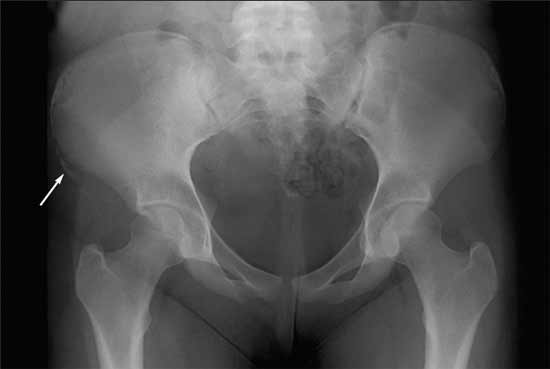
Image courtesy of Jean Someshwar, MD, J. Stephen Kroll, MD, and Linda S. Nield, MD.
Click here to return to the first image.